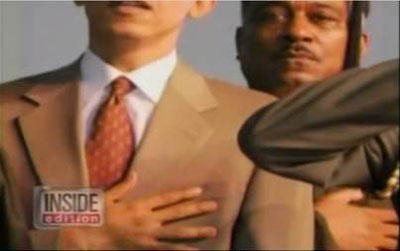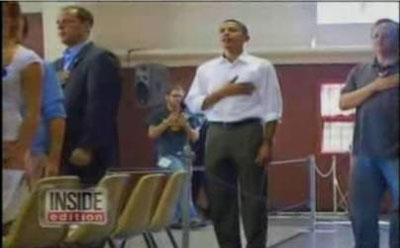@McGentrix,
http://www.snopes.com/politics/obama/stance.asp
Origin:Although the custom is sometimes more honored in the breach than in the observance, the U.S. Flag Code states that:
During a rendition of the national anthem when the flag is displayed all present except those in uniform should stand at attention facing the flag with the right hand over the heart.
Given how finely-attuned candidates for high office usually are to the importance of symbolism, Illinois senator (and Democratic presidential hopeful) Barack Obama caused something of a stir in September 2007 when he was seemingly spotted (as in the image shown above) not observing the hand-over-heart protocol during a playing of "The Star-Spangled Banner" at an Indianola, Iowa, steak fry attended by the six top Democratic presidential candidates.
The photograph itself is real, one of several images of the Iowa steak fry event published by Time, and shows Barack Obama standing with his hands clasped just below his waist, while New Mexico governor Bill Richardson, New York senator Hillary Clinton, and Ruth Harkin (wife of Iowa senator Tom Harkin) stand with their hands held over their hearts. It's difficult to establish context from a single still image, but other accounts (including the following ABC News video of the event) documented that the picture was as described:
(It's not clear from the photograph or the video just what the candidates are looking at in the photograph and video. The Flag Code advises that they should be "standing at attention facing the flag," but none of them is facing the flag displayed behind the platform on which they're standing. Presumably another flag was in place off to the right of the platform, since most of the candidates are facing that direction.)
As we noted earlier, although the U.S. Flag Code still specifies that those present should stand "with the right hand over the heart" during the playing of the U.S. national anthem, that particular form is one that has generally come to be observed less and less consistently among the general public over the decades:
Experts on the national anthem say the law seems a bit out of date, given its reference to a man's "headdress." Yet it's still cited in several military manuals found on the Web.
Modern custom does not require a hand over the heart, said Anne Garside, director of communication for the Maryland Historical Society, home of the original manuscript of The Star-Spangled Banner.
"I think the bottom line is that you show respect with your demeanor," she said. "Whether you put your hand over your heart, hold your hat at shoulder level or waist level, is really in this day and age irrelevant."
As for whether this incident was an "accident," whether Senator Obama habitually declines to perform the hand-over-heart gesture, or whether there's any particular meaning to the (non-)action, an Obama campaign spokesperson responded: "Sometimes he does, sometimes he doesn't. In no way was he making any sort of statement, and any suggestion to the contrary is ridiculous." The senator himself said that "My grandfather taught me when I was two. During the Pledge of Allegiance, you put your hand over your heart. During the national anthem, you sing."
When television's Inside Edition ran a segment on this issue, they included some images (supplied by the Obama campaign) of the senator standing with his hand over his heart during other playings of the national anthem:
The text accompanying some versions of the e-mailed photo claimed that Senator Obama "refused to say the Pledge of Allegiance." The activity taking place during the scene in the photograph involved the playing of the U.S. national anthem, not a recitation of the Pledge of Allegiance. The following video clips show Barack Obama reciting the Pledge during the opening of Senate sessions:

